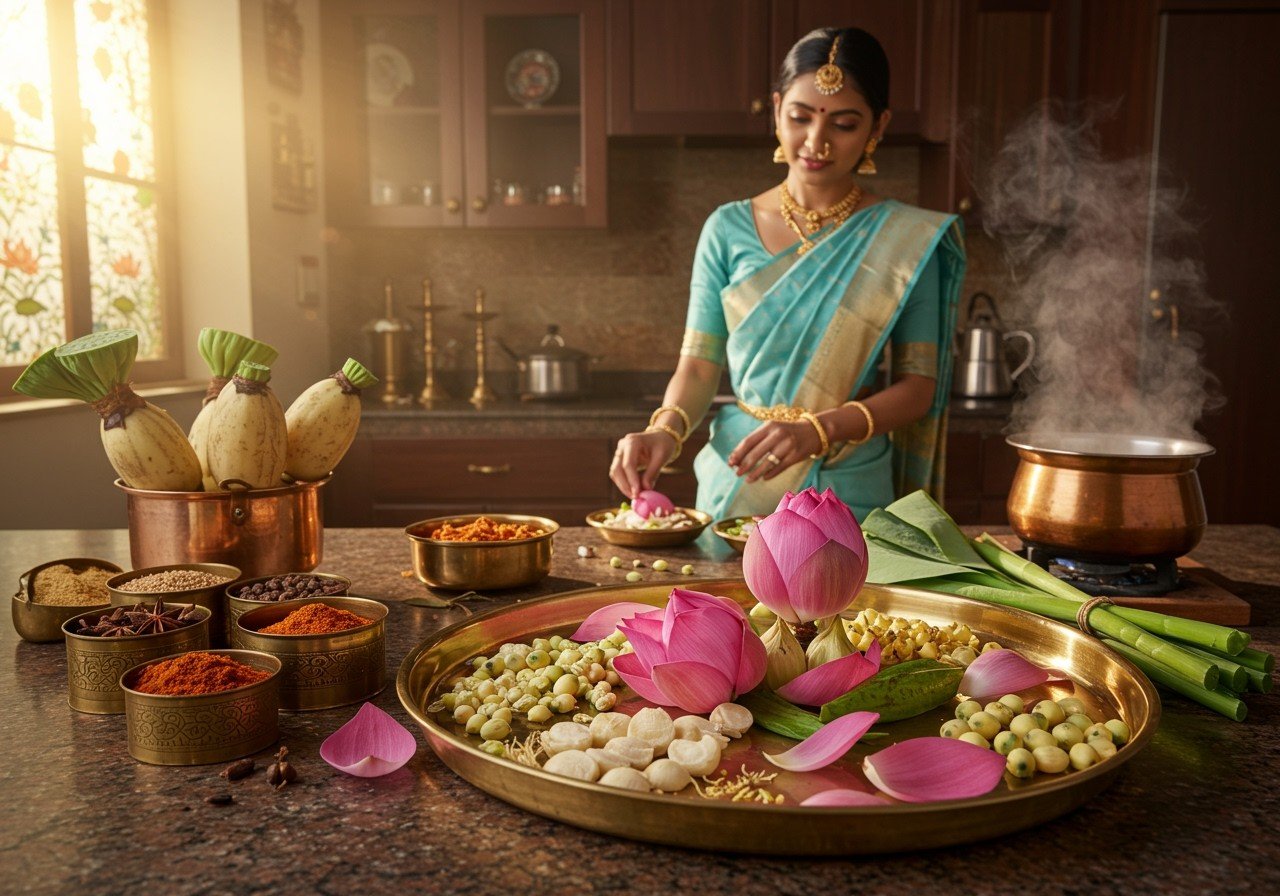
The lotus plant, scientifically known as Nelumbo Nucifera, holds a position of reverence in Indian culture, seamlessly weaving its way into both spiritual practices and culinary traditions. This aquatic marvel, admired for its resilience and exquisite beauty, transcends its symbolic representation of purity and enlightenment. From root to seed, every part of the lotus plant finds a place in the kitchens of India, valued for its unique flavor profile and a wealth of health benefits. Let’s delve into the culinary uses of this remarkable plant, exploring its significance in traditional Indian recipes and its enduring cultural resonance.
The Culinary Heritage of the Lotus in India
Deeply rooted in Indian culinary heritage, the lotus plant is a recurring ingredient in traditional dishes across various regions. Beyond its symbolic importance, it offers notable nutritional value, being a good source of fiber, which aids digestion. The lotus’s association with purity and spiritual growth further elevates its status in Indian culture.
The versatility of the lotus allows it to be incorporated into a diverse range of dishes, from soothing soups and refreshing salads to decadent desserts. Each part of the plant plays a unique role in the kitchen:
- Root: The crunchy and subtly sweet lotus root, often called kamal kakdi, lends itself beautifully to savory preparations, adding a unique textural element to stir-fries, curries, and even deep-fried snacks. You can find fresh lotus stems at Poojn.in.
- Seeds: Known as makhana, lotus seeds are cherished for their delicate flavor and poppable texture. They frequently feature in desserts, snacks, and religious offerings, embodying a sense of purity and wholesomeness. Explore our range of Mahosadhi at Poojn.in.
- Leaves: The large, elegant lotus leaves are not just visually appealing but also serve as natural wrappers for steaming rice dishes, imparting a subtle, earthy fragrance to the food. They can also be used as eco-friendly serving platters, adding a touch of tradition to meals.
The availability of fresh lotus being seasonal further adds to its value, influencing its culinary applications throughout the year.
A Symphony of Flavors: Lotus Root in Indian Cuisine
Lotus root, with its satisfying crunch and earthy undertones, stands as a beloved ingredient in Indian kitchens. Its versatility shines through in both traditional dishes passed down through generations and innovative modern creations. Let’s explore some inspiring ways to savor the distinct character of lotus root:
Kamal Kakdi Sabzi: A North Indian Classic
This comforting dish showcases the rich flavor of lotus root, simmered in a medley of aromatic spices like cumin, turmeric, and garam masala. The addition of tomatoes and onions creates a savory gravy that perfectly complements the subtle sweetness of the lotus root. Served hot with roti or rice, Kamal Kakdi Sabzi is a true embodiment of homely Indian flavors.
Lotus Root Stir-Fry: A Quick and Flavorful Delight
For a light yet satisfying meal, try a simple Lotus Root Stir-Fry. Thinly sliced lotus root is quickly stir-fried in sesame oil with garlic, green chilies, and a dash of soy sauce, creating a dish that’s both flavorful and easy to prepare. It’s a perfect side dish to accompany any Indian main course.
Lotus Root Chips: A Healthy and Crispy Snack
Looking for a snack that’s both delicious and guilt-free? Lotus root chips are the answer. Thinly sliced lotus root is tossed in olive oil, seasoned with salt and pepper, and baked to a satisfying crisp. These chips offer a healthier alternative to traditional fried snacks while still providing a delightful crunch.
Pickled Lotus Root: A Tangy Condiment
Add a burst of flavor to your meals with pickled lotus root. Sliced lotus root is marinated in a vibrant mixture of vinegar, sugar, and chili flakes, allowing the flavors to meld and deepen overnight. This tangy condiment is a wonderful accompaniment to rice dishes, curries, or simply enjoyed as a side.
The Culinary Gems of Lotus Seeds (Makhana)
Makhana, or lotus seeds, are treasured for their nutritional value and culinary versatility. They offer a light, airy texture and a subtly sweet flavor, making them a popular ingredient in both sweet and savory dishes.
Makhana Kheer: A Creamy, Sweet Indulgence
Makhana Kheer is a classic Indian dessert that celebrates the delicate sweetness of lotus seeds. Roasted makhana is simmered in milk infused with cardamom and sugar, creating a rich, creamy dessert that’s both comforting and flavorful. Garnished with nuts, it becomes a true feast for the senses.
Roasted Makhana: A Wholesome Snack
For a quick and nutritious snack, try roasted makhana. The seeds are simply roasted in ghee and seasoned with a pinch of salt and spices. This light and crunchy snack is perfect for any time of day.
The Art of Cooking with Lotus Leaves
Lotus leaves, with their large surface area and subtle aroma, are often employed in unique culinary applications.
Lotus Leaf Rice: An Aromatic Delight
Lotus Leaf Rice is a dish that beautifully captures the essence of the lotus plant. Rice, along with a medley of spices and vegetables, is carefully wrapped and steamed in a lotus leaf. The leaf imparts a unique fragrance to the rice, elevating the dish to a new level of sensory experience.
Patra: A Traditional Steamed Delicacy
Patra, a traditional dish from Western India, features spiced gram flour batter steamed in lotus leaves. The leaves impart a subtle earthiness to the batter, creating a dish that is both flavorful and visually appealing, perfect for special occasions.
Sourcing Lotus Products from Poojn.in
For authentic lotus plant products to enrich your culinary creations and rituals, look no further than Poojn.in. We offer a carefully curated selection of:
- Fresh lotus stems (kamal kakdi): Perfect for stir-fries, curries, and other savory dishes.
- Dried lotus seeds (makhana): Ideal for snacks, desserts, and religious offerings.
- Lotus root powder: A convenient option for thickening sauces and adding a subtle lotus flavor to your cooking.
- Lotus flower petals: Add a touch of elegance and fragrance to your dishes and beverages.
You can explore a variety of auspicious ingredients at Poojn.in’s Jari Booti collection or find specific items like Sarbosadhi for your puja needs. We also offer a range of holy foods, holy idols, holy jewellery, holy cosmetics, and holy utensils to complete your spiritual practices.
Our lotus products are sourced with utmost care, ensuring purity and freshness. We offer pan-India delivery, bringing the goodness of the lotus plant directly to your doorstep. Visit our website www.poojn.in to place your order, or connect with us at 03369029784 or via WhatsApp at 9476142738.
Embark on a Culinary Journey with the Lotus
The lotus plant, steeped in cultural significance and culinary richness, invites you to explore a world of flavors and textures. From the satisfying crunch of Kamal Kakdi Sabzi to the sweet embrace of Makhana Kheer, each dish offers a unique culinary experience. By incorporating the lotus into your meals, you partake in a tradition that celebrates both taste and spiritual well-being. As you prepare these dishes, whether for a family gathering or a festive occasion, the lotus plant infuses a touch of elegance, tradition, and wholesome goodness into your culinary journey.
Frequently Asked Questions about the Lotus Plant
What parts of the lotus plant are edible?
The lotus offers a variety of edible parts, including the seeds, roots (also called rhizomes), and young leaves. Each part has its own unique flavor and texture, adding diverse culinary possibilities.
How do I prepare lotus root for cooking?
Begin by peeling the skin of the lotus root. Then, slice it thinly and soak the slices in water with a splash of vinegar. This helps prevent discoloration and maintains the root’s crispness. Now it’s ready for your favorite recipes!
What are some popular dishes featuring lotus seeds?
Lotus seeds, or makhana, shine in both sweet and savory preparations. Popular recipes include makhana kheer, roasted makhana for a healthy snack, and even lotus seed paste used in certain desserts.
Can lotus leaves be incorporated into cooking?
Absolutely! Lotus leaves add a unique aroma and visual appeal when used to wrap food for steaming. Lotus leaf rice and dumplings are classic examples.
Is the lotus flower ever used in cooking?
While the petals themselves aren’t a common cooking ingredient, they can be used for garnishing or to infuse delicate flavors into teas and beverages. They add a touch of visual elegance to dishes. You can find dried lotus flower petals along with other Mahosadhi items at Poojn.in.
What are the health benefits associated with consuming lotus plant parts?
The lotus plant is a good source of essential nutrients, including vitamins, minerals, and fiber. Lotus root aids digestion, lotus seeds provide protein, and the plant as a whole boasts antioxidant properties.
Are there any specific precautions to keep in mind when cooking with lotus plant parts?
Thorough washing is crucial to remove any impurities. Ensure the parts are cooked properly to maximize their flavor and ensure safe consumption.
Can lotus plant parts be used in traditional Indian recipes?
Yes, lotus has long been a part of Indian culinary heritage. Dishes like kamal kakdi sabzi and makhana kheer are prime examples of its traditional use. Consider also making delicious recipes for Ganesh Chaturthi with some of these ingredients. You can also explore the story of Lord Krishna and perhaps find inspiration for recipes in his life story.


